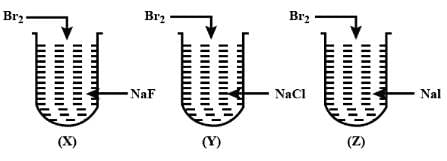NEET Exam > NEET Tests > Topic-wise MCQ Tests for NEET > Test: Group-17 Elements - NEET MCQ
Test: Group-17 Elements - NEET MCQ
Test Description
10 Questions MCQ Test Topic-wise MCQ Tests for NEET - Test: Group-17 Elements
Test: Group-17 Elements for NEET 2024 is part of Topic-wise MCQ Tests for NEET preparation. The Test: Group-17 Elements questions and answers have been
prepared according to the NEET exam syllabus.The Test: Group-17 Elements MCQs are made for NEET 2024 Exam. Find important
definitions, questions, notes, meanings, examples, exercises, MCQs and online tests for Test: Group-17 Elements below.
Solutions of Test: Group-17 Elements questions in English are available as part of our Topic-wise MCQ Tests for NEET for NEET & Test: Group-17 Elements solutions in
Hindi for Topic-wise MCQ Tests for NEET course. Download more important topics, notes, lectures and mock
test series for NEET Exam by signing up for free. Attempt Test: Group-17 Elements | 10 questions in 10 minutes | Mock test for NEET preparation | Free important questions MCQ to study Topic-wise MCQ Tests for NEET for NEET Exam | Download free PDF with solutions
Test: Group-17 Elements - Question 1
The correct order of increasing electron affinity of halogen of
Detailed Solution for Test: Group-17 Elements - Question 1
Test: Group-17 Elements - Question 2
Which is the correct arrangement of the compounds based on their bond strength?
Detailed Solution for Test: Group-17 Elements - Question 2
| 1 Crore+ students have signed up on EduRev. Have you? Download the App |
Test: Group-17 Elements - Question 3
The comparatively high boiling point of hydrogen fluoride is due to:
Detailed Solution for Test: Group-17 Elements - Question 3
Test: Group-17 Elements - Question 4
The high reactivity of fluorine is due to its _____ dissociation energy. Its shows only ______ oxidation state. It has_______electron affinity than chlorine. Among all hydrogen halides boiling point is highest for_______.
Detailed Solution for Test: Group-17 Elements - Question 4
Test: Group-17 Elements - Question 5
The property of halogens which is not correctly matched is
Detailed Solution for Test: Group-17 Elements - Question 5
Detailed Solution for Test: Group-17 Elements - Question 6
Test: Group-17 Elements - Question 7
What is the correct observation when Br2 is treated with NaF, NaCl and Nal has taken in three test-tubes labeled as (X),(Y) and (Z)?

Detailed Solution for Test: Group-17 Elements - Question 7
Detailed Solution for Test: Group-17 Elements - Question 8
Detailed Solution for Test: Group-17 Elements - Question 9
Detailed Solution for Test: Group-17 Elements - Question 10
|
9 docs|1272 tests
|
Information about Test: Group-17 Elements Page
In this test you can find the Exam questions for Test: Group-17 Elements solved & explained in the simplest way possible.
Besides giving Questions and answers for Test: Group-17 Elements, EduRev gives you an ample number of Online tests for practice












